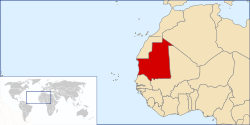
Back بوابة:موريتانيا Arabic Portal:Mauretanien German Portal:Mauritania Spanish Portail:Mauritanie French Gerbang:Mauritania Malay Portal:Mauritânia Portuguese Портал:Мавритания Russian باب:موریتانیہ Urdu
The Mauritania Portal - بوابة موريتانيا
Mauritania, officially the Islamic Republic of Mauritania, is a country in Northwest Africa. It is bordered by the Atlantic Ocean to the west, Western Sahara to the north and northwest, Algeria to the northeast, Mali to the east and southeast, and Senegal to the southwest. By land area Mauritania is the 11th-largest country in Africa and 28th-largest in the world; 90% of its territory is in the Sahara. Most of its population of some 4.3 million lives in the temperate south of the country; roughly a third of the population is concentrated in the capital and largest city, Nouakchott, on the Atlantic coast. The country's name derives from Mauretania, the Latin name for a region in the ancient Maghreb. It extended from central present-day Algeria to the Atlantic. Berbers occupied what is now Mauritania by the beginning of the third century AD. Groups of Arab tribes migrated to this area in the late seventh century, bringing with them Islam, Arab culture, and the Arabic language. In the early 20th century, Mauritania was colonized by France as part of French West Africa. It achieved independence in 1960. However, the country has since experienced recurrent coups and periods of military dictatorship. The 2008 Mauritanian coup d'état was led by General Mohamed Ould Abdel Aziz, who won subsequent presidential elections in 2009 and 2014. He was succeeded by General Mohamed Ould Ghazouani following the 2019 elections, head of an autocratic government with a very poor human rights record, particularly because of its perpetuation of slavery; the 2018 Global Slavery Index estimates there are about 90,000 slaves in the country (or 2.1% of the population). Despite an abundance of natural resources, Mauritania remains poor; its economy is based primarily on agriculture and fishing. Mauritania is culturally and politically part of the Arab world. It is a member of the Arab League and Arabic is the official language. The official religion is Islam, and almost all inhabitants are Sunni Muslims. Despite its prevailing Arab identity, Mauritanian society is multiethnic. The Bidhan, or so-called "white moors", make up 30% of the population, while the Haratin, or so-called "black moors", comprise 40%. Both groups reflect a fusion of Arab-Berber ethnicity, language, and culture. The remaining 30% of the population comprises various sub-Saharan ethnic groups. (Full article...) Selected article -Hodh El Gharbi (Arabic: ولاية الحوض الغربي, romanized: Wilāyat al-Ḥawḍ al-Gharbī, lit. 'Western Basin Region') is a region in southern Mauritania, with an area of 53,400 square km. The population at the 2013 census was 294,109. Its capital is Aïoun (formerly called Ayoun el Atrous). The region borders the Mauritanian regions of Tagant to the north, Hodh Ech Chargui to the east and Assaba to the west. To the south in borders Mali, and a part of Malian territory protrudes into the region. The Aoukar basin, which formerly gave name to a greater region, is located in the northern and central part of Hodh El Gharbi, extending eastwards. As of 2013, the population of the region was 294,109, compared to 274,443 in 2011. There were 47.53 per cent females and 52.47 per cent males. As of 2008, the activity rate was 52.00 and economic dependency ratio was 0.88. As of 2008, the literacy rate for people aged 15 years and over was 67.10. (Full article...) This is a Good article, an article that meets a core set of high editorial standards.
 Nouakchott (/nwækˈʃɒt, nwɑː-/ nwa(h)k-SHOT) is the capital and largest city of Mauritania. Located in the southwestern part of the country, it is one of the largest cities in the Sahara. The city also serves as the administrative and economic center of Mauritania. Once a mid-sized coastal village, Nouakchott was selected as the capital for the nascent nation of Mauritania, with construction beginning in 1958. It was originally designed to accommodate a population of 15,000, but experienced significant population growth in the 1970s when many Mauritanians fled their home villages due to drought and increasing desertification. Many of the newcomers settled in slum areas of the city that were poorly maintained and extremely overcrowded. By the mid-1980s, Nouakchott's population was estimated to be between 400,000 and 500,000. (Full article...) CategoriesGeneral images -The following are images from various Mauritania-related articles on Wikipedia.
Related portalsWikiProjects
Topics in MauritaniaCities and towns
Preview warning: Page using Template:Largest cities with unknown parameter "img_1" Preview warning: Page using Template:Largest cities with unknown parameter "img_2" Preview warning: Page using Template:Largest cities with unknown parameter "img_3"
CommunesAssociated WikimediaThe following Wikimedia Foundation sister projects provide more on this subject:
Discover Wikipedia using portals | ||||||||||||||||||||||||||||||||||||||||||||||||||||||||||||||||||||||||||||||||||||||||||||||||||||||||































